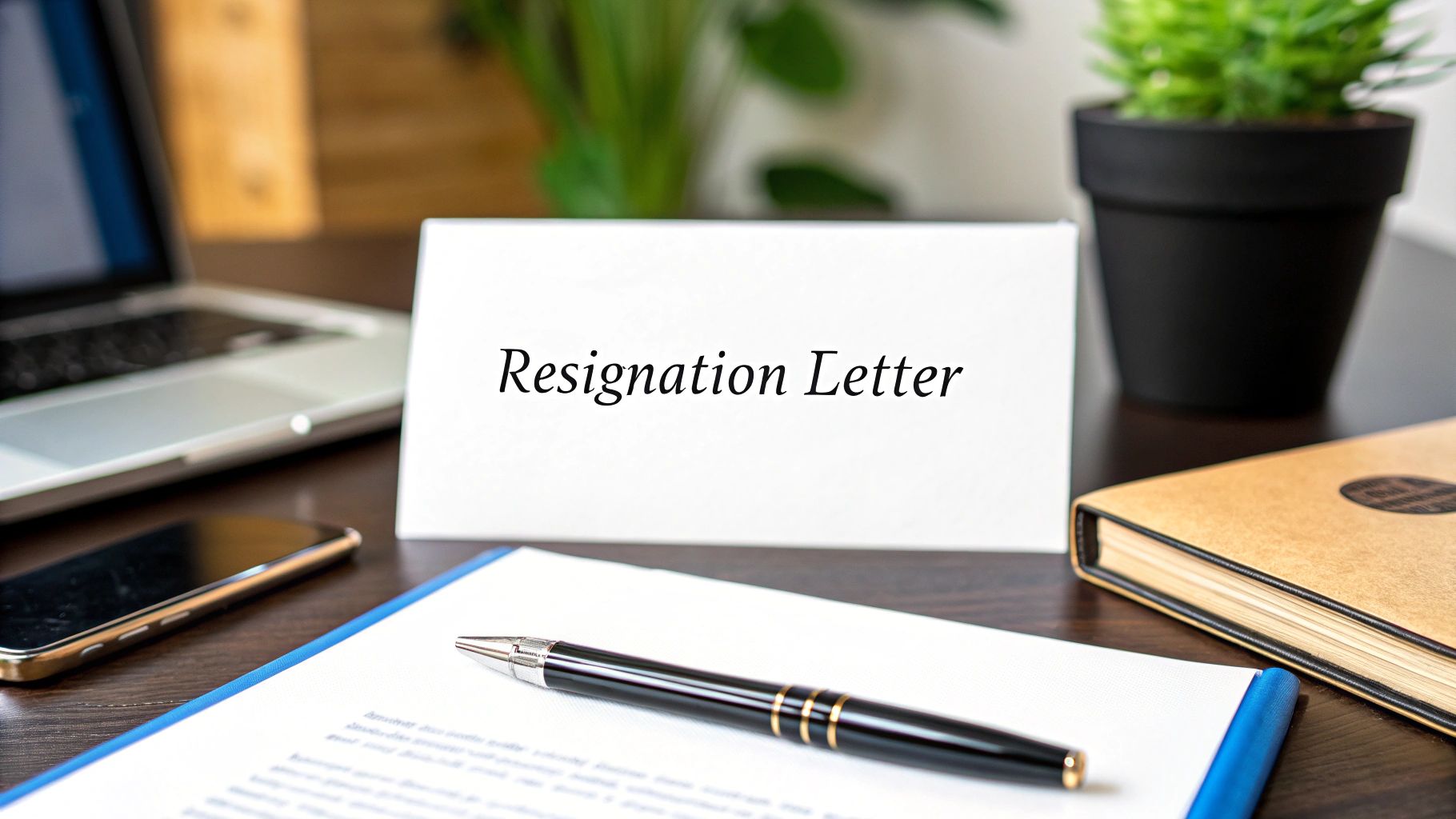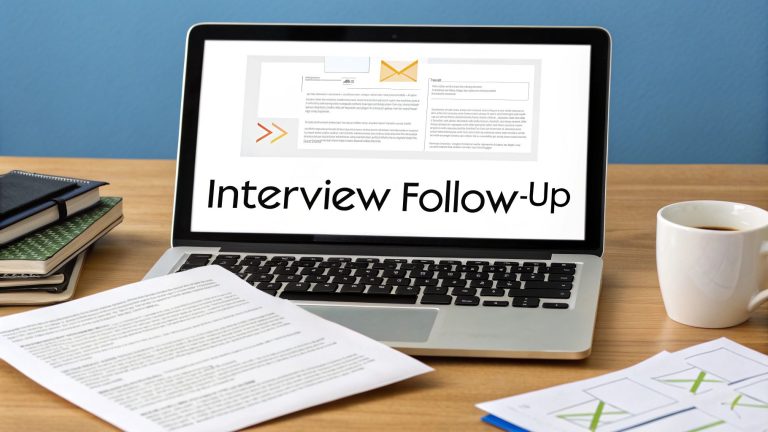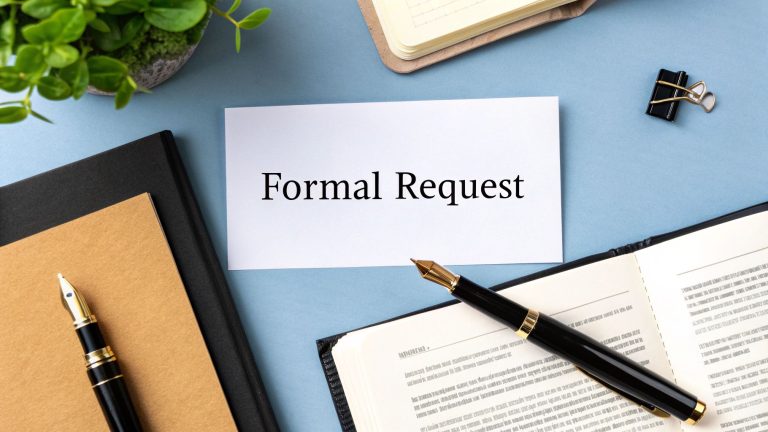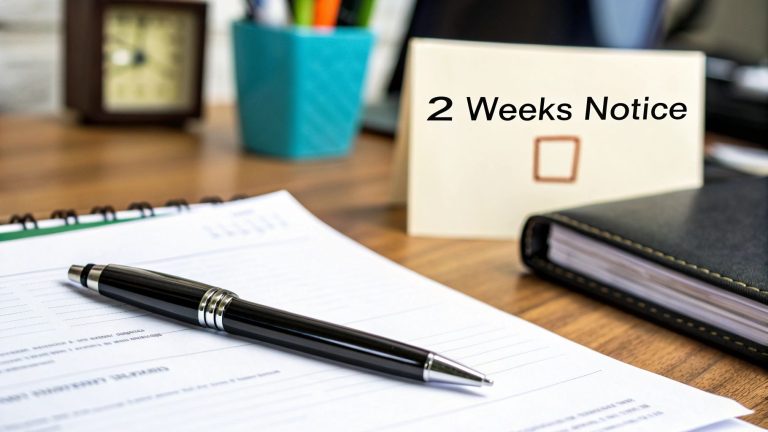Writing a good resignation letter boils down to four simple things: a clear statement that you're leaving, your last day, a real offer to help with the transition, and a professional sign-off. Think of it as your final professional footprint at the company. Keeping it clean, brief, and positive is the key to leaving on a high note.
Why Your Resignation Letter Matters More Than You Think
Leaving a job is a big deal, and that letter you write is more than just a formality. It’s a chance to cement your professional reputation, keep your network intact, and make sure your exit is as smooth as possible. How you leave a role can echo through your career for years to come.
This isn't just a hunch. We're seeing a massive shift in the workforce. A recent survey from LinkedIn and Microsoft found that a staggering 46% of employees are thinking about quitting their jobs in 2025. That's a jump from 40% in 2021, a trend some are calling the "Great Re-Resignation." It’s clear that professionals are on the move now more than ever.
What a Formal Resignation Actually Does
A well-thought-out letter accomplishes a few crucial things that just telling your boss you're leaving can't. It creates an official, written record for HR, locking in your departure date and preventing any confusion about timelines or final pay.
But it’s not just about the paperwork. The letter sets a respectful and cooperative tone for your last couple of weeks. It shows you're handling your exit maturely and with consideration for the team you're leaving behind. This is so important for a few reasons:
- Future References: You’ll probably need your old boss as a reference someday.
- Networking: Your colleagues might be your future collaborators, clients, or hiring managers.
- Industry Reputation: People talk. A professional exit helps maintain your good name.
Your resignation letter is your last chance to frame the story of your departure. Use it to build a bridge, not burn one. It’s the final page of this chapter in your career, and you want to write it in a way that sets you up for the next one.
To make sure your departure is truly seamless, think of the letter as just one piece of a bigger puzzle. Following a comprehensive employee exit checklist can help you manage everything else, from transferring your knowledge to returning company equipment, ensuring nothing gets missed.
Anatomy of the Perfect Resignation Letter
Think of your resignation letter as a simple, professional blueprint. Each part has a specific job, and getting them right ensures your message is clear, respectful, and leaves a great final impression. We’ll break down exactly how to build your letter, piece by piece, so you feel confident in what you’re writing.
It’s all about removing the guesswork. From the header to your signature, let’s build a polished letter together.
The Professional Header
Before you even start writing, the top of your letter needs to be formatted correctly. This isn't just about looking professional—it gives HR all the details they need to process your departure without a hitch. If you want a deeper dive into layouts, check out our tips on how to format a letter.
Your header should always include:
- Your Contact Information: Your full name, address, phone number, and a personal email address.
- The Date: The date you're officially submitting the letter.
- Recipient’s Information: Your manager's full name, their official title, and the company’s name and address.
This simple structure immediately signals that this is an official document.
A clean, well-organized header sets a professional tone before the first sentence is even read. It’s a small detail that shows you’re handling your resignation with care and seriousness.
The Opening Statement
Your first paragraph needs to be direct and unambiguous. This is where you state your intention to resign and provide your last day. There's no need to beat around the bush; clarity is key here.
For example, a strong, straightforward opening sounds like this:
"Please accept this letter as formal notification that I am resigning from my position as [Your Job Title] at [Company Name]. My final day of employment will be [Your Last Day]."
It gets right to the point while staying polite. Just make sure your last day lines up with your company’s notice period policy, which is typically two weeks.
The Body of the Letter
After the opening, the middle of your letter is where you can smooth things over. It really has two main jobs: saying thank you and offering to help with the transition. These two things are crucial for keeping your professional relationships intact.
Expressing Gratitude
Even if you're counting down the minutes until you leave, find something positive to mention. Think about a skill you learned, a big project you were proud of, or your appreciation for the team you worked with.
A simple sentence like, "I am grateful for the opportunity to have worked on the [Project Name] project and for the skills I've developed here," works perfectly. It’s genuine and professional.
Offering Transitional Support
Next, state your willingness to ensure a smooth handover. This shows you're committed to your responsibilities right up until your last day. It's a small gesture that goes a long way.
You could write something like, "I am dedicated to ensuring a seamless transition and will do everything I can to wrap up my duties and train my replacement."
This offer shows real professionalism and consideration for your colleagues. During the "Great Resignation," an unprecedented 47 million Americans quit their jobs in 2021. That period really drove home how much a smooth, professional exit matters—both for the person leaving and the company. You can read more about the trends of this significant workforce shift.
The Closing and Signature
Finally, you need to wrap it all up with a professional sign-off. Keep it simple and classic.
Choose a closing that feels right, like:
- Sincerely
- Best regards
- Respectfully yours
Follow this with your handwritten signature (if you're handing in a paper copy), and then your typed full name below it. If you’re sending your resignation over email, just typing your full name after the closing is perfect. It’s the final touch that leaves a polished and respectful impression.
Setting the Right Tone: What to Say and What to Skip
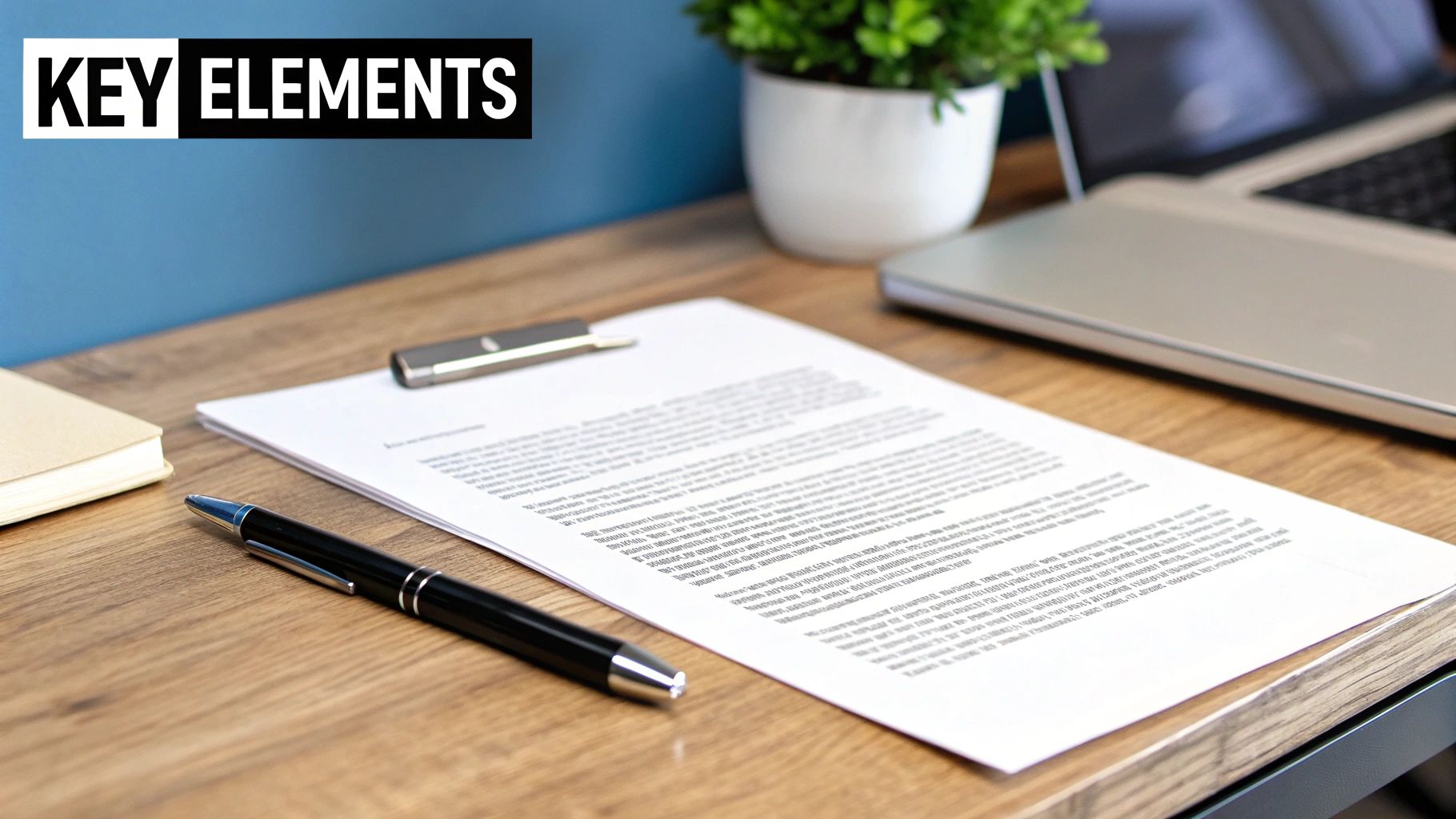
If the structure of your resignation letter is the skeleton, then the tone is its personality. It’s what your manager and colleagues will remember long after you've moved on. The goal here is to come across as professional, gracious, and forward-looking—even if your time at the company wasn't perfect.
This is where your effective workplace communication skills really shine. The words you choose should convey respect and gratitude, making sure you leave professional relationships in a good place. This isn't about being fake; it’s about being strategic and focusing on the positive to protect your long-term reputation.
What You Should Always Include
Your letter needs to radiate positivity and professionalism. Concentrate on showing genuine appreciation for the opportunities you were given, which reinforces that you value your time there and are leaving on good terms.
Try to think of specific skills you gained or experiences that stood out. A little detail goes a long way in making your gratitude feel authentic.
Here’s how you can nail that positive tone:
- Acknowledge specific growth: "I'm especially grateful for the chance to lead the Alpha Project, which helped me develop valuable project management skills."
- Show appreciation for your team: "Thank you for creating such a collaborative environment. I’ve learned so much from my talented colleagues."
- Mention positive mentorship: "I truly appreciate your guidance and support over the past three years."
These kinds of statements are simple, honest, and help build a positive final impression. They frame your departure as a natural step in your career, not an escape. If you're looking for more tips on professional correspondence, it's always a good idea to brush up on the essentials of letter-writing etiquette.
What You Must Absolutely Skip
Alright, now for the most critical part: what to leave out. Your resignation letter is a formal HR document that becomes part of your permanent employee record. It is not the time or place to air grievances, settle scores, or vent your frustrations.
Think of your resignation letter as a press release for your career. Any negativity will only reflect poorly on you and can burn bridges you might need to cross again someday.
Steer clear of these topics completely:
- Complaints about your boss or coworkers: Never put criticism of individuals in writing. It comes across as unprofessional and petty.
- Criticism of the company: This isn't the forum to list everything you think is wrong with company policy or culture.
- Overly emotional language: Avoid dramatic phrases that show anger or disappointment. Keep your language neutral and professional.
- Details about your new job: Don't mention your new company, your new salary, or why your new role is so much better. It can sound like bragging and is completely unnecessary.
Remember, the goal is to make a graceful exit. If you have constructive feedback, save it for your exit interview—and even then, deliver it carefully. Your written letter should remain entirely positive.
Resignation Letter Examples for Any Situation
A one-size-fits-all resignation letter just doesn't cut it. The real art is in matching your letter's tone and content to your specific situation—your reasons for leaving, the relationship you have with your boss, and your company's culture all play a huge role.
Think of these examples as starting points, not rigid templates. You can pick the one that feels closest to your circumstances and then tweak it to make it genuinely yours. This way, your final message will come across as authentic and appropriate.
This infographic breaks down a few different approaches you can take.
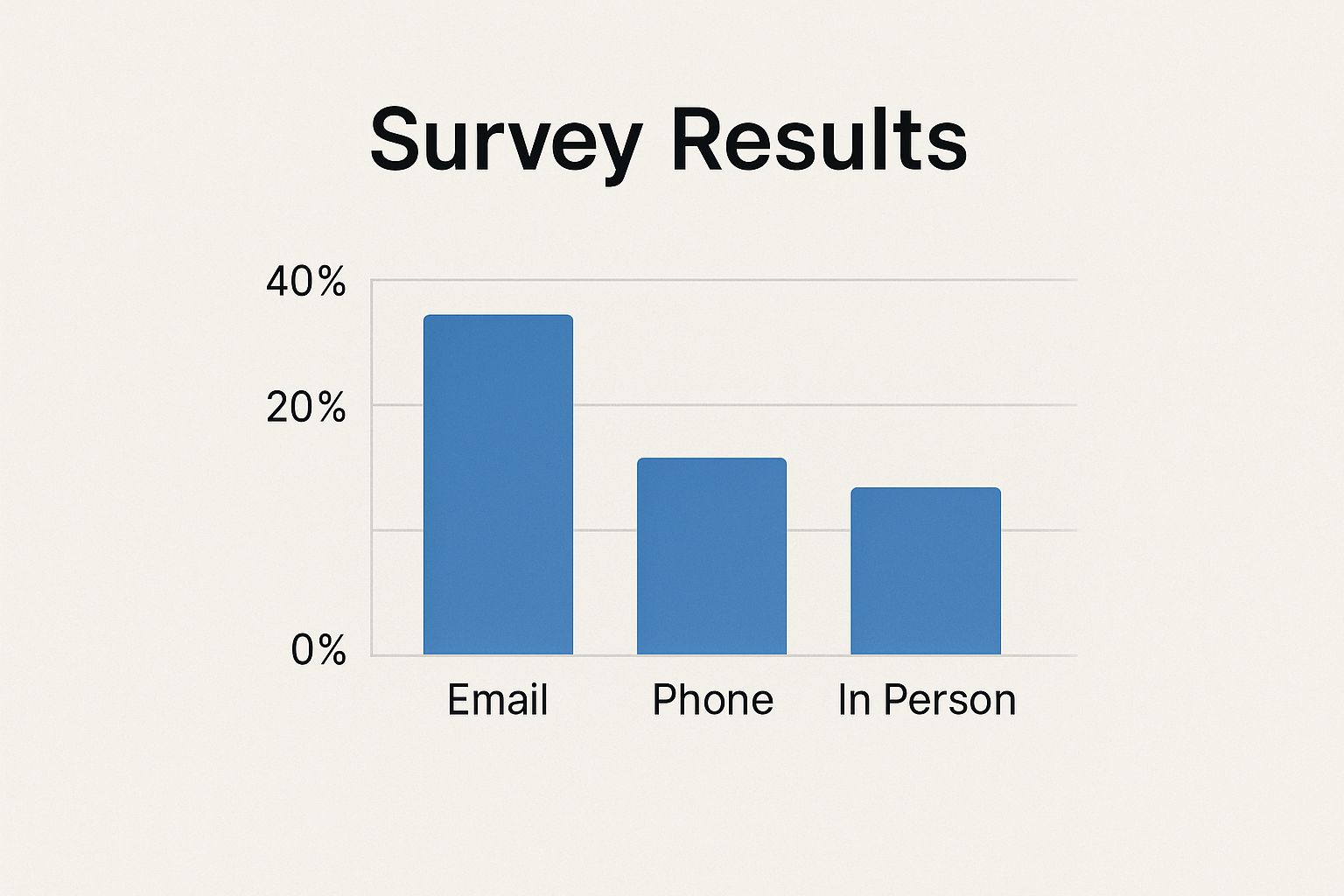
Let's dive into these examples so you can craft a polished letter that hits all the right notes for your unique situation.
The Standard Professional Resignation
This is your classic, all-purpose resignation letter. It’s perfect for most corporate environments where you want to be direct, respectful, and cover the essentials without getting overly emotional.
This approach works best when your relationship with your manager is professional and you simply need to handle your departure cleanly and courteously.
A good professional letter keeps it simple:
- The Opener: State your intention to resign and clearly specify your last day of employment.
- The Body: A short paragraph expressing gratitude for the opportunity is a nice touch. It's also professional to offer your help during the transition period.
- The Closing: End with a polite sign-off like "Sincerely" or "Best regards."
This format is clean, efficient, and leaves a lasting professional impression. It’s a safe and effective bet for almost any scenario.
The Warm and Gracious Resignation
Sometimes, you’re not just leaving a job; you’re leaving a team you’ve genuinely connected with. When you have a great relationship with your manager and coworkers, a standard, formal letter can feel a little cold.
This is where a warmer, more personal tone comes in. While it’s still a professional document, this letter allows you to express genuine gratitude and acknowledge the people you’ve worked with.
A warm resignation letter is more than just a formality—it’s a nod to the relationships you've built. It’s your chance to say, "I value the time we spent together," which is incredibly important for keeping your professional network strong.
You could add a specific, positive memory or a line about the team. Something like, "I'll always appreciate the mentorship I received here and the camaraderie our team shared," adds a human touch that a standard template just can't match.
The Simple and Direct Resignation
What if you've only been with the company for a short time? Or maybe it was a contract or temporary role. In these cases, a long, heartfelt letter can feel out of place. A simple, direct resignation is all you need.
This version is lean and gets right to the point:
- State your resignation: "Please accept this as formal notification of my resignation."
- Provide your last day: "My final day with the company will be [Your Last Day]."
- Offer a simple thanks: "Thank you for the opportunity."
It’s professional, incredibly brief, and perfectly suited for short-term roles where a deep expression of gratitude isn’t really expected. If you're in a rush and need a solid draft, using a free resignation letter generator can give you a polished and customized starting point in just a few clicks.
The Remote Position Resignation
Leaving a remote job comes with its own set of considerations. Since you can't have a quick chat in the hallway, your written communication needs to be crystal clear and reassuring. The core content is similar to a standard letter, but you absolutely need to address the remote handover process.
Make a point to include a sentence like, "I am committed to ensuring a seamless transition and will be available via video call to train my replacement and fully document all my processes."
This proactive offer shows you’re thinking ahead and reassures your manager that your physical absence won't create chaos—a major concern for any distributed team.
Choosing the Right Resignation Template
Not sure which style fits your situation? This table breaks down when to use each type of letter based on the tone you want to convey.
| Scenario | Key Tonal Elements | When to Use |
|---|---|---|
| Standard Professional | Formal, respectful, direct, efficient | Most corporate settings; when you have a standard professional relationship with your manager. |
| Warm & Gracious | Personal, appreciative, sincere, friendly | Leaving a job you loved; when you have strong, positive relationships with your team and manager. |
| Simple & Direct | Concise, to-the-point, no-frills | Short-term employment, contract roles, or temporary positions where formality isn't required. |
| Remote Position | Clear, proactive, reassuring, collaborative | Any remote role; it's crucial to address the virtual handover process directly. |
Ultimately, the goal is to choose a template that feels right for you. Use it as a foundation, then add your own voice to make it authentic.
How to Handle Difficult Resignations
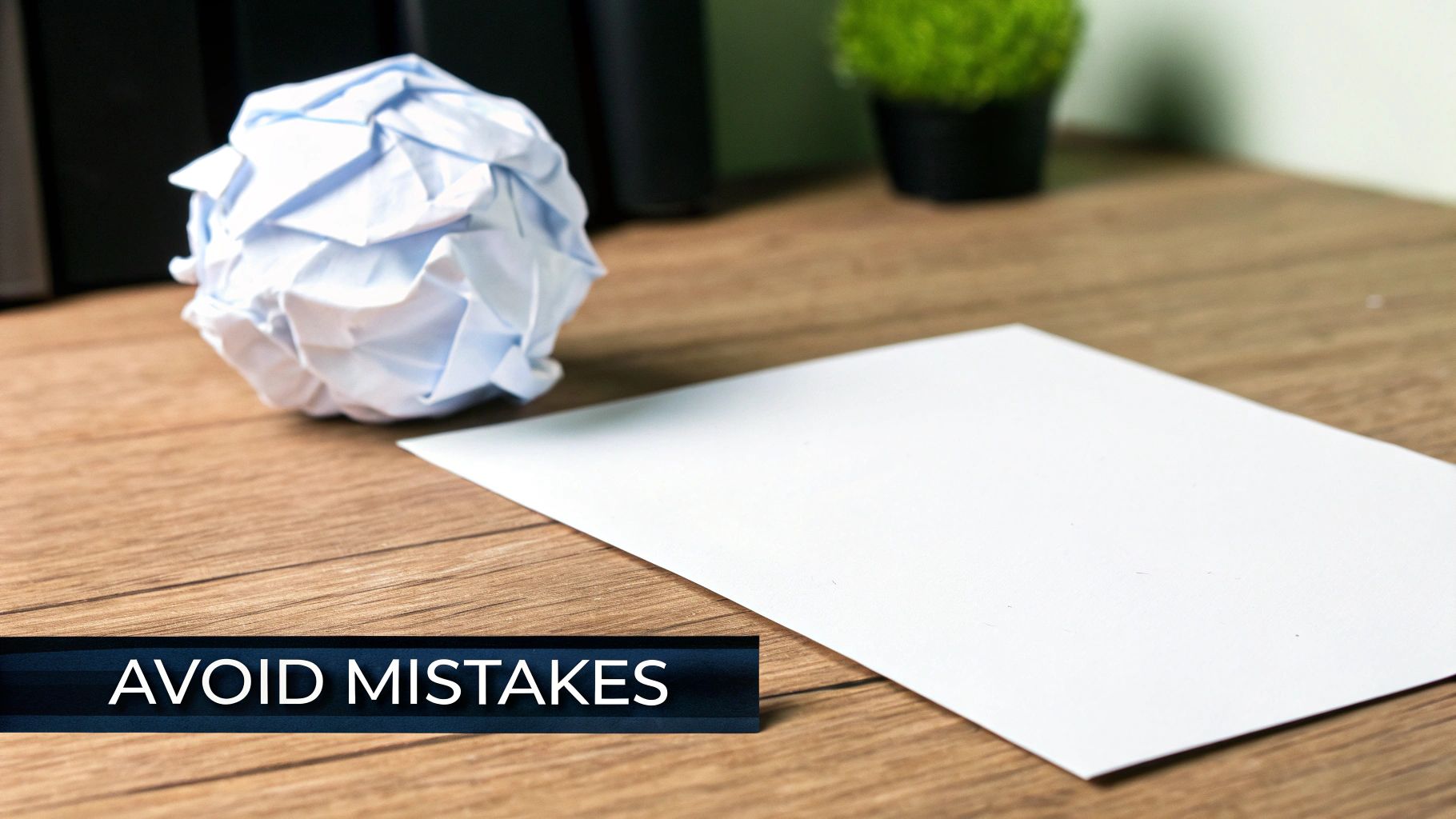
Let's be honest—leaving a job isn't always a happy occasion. If you're walking away from a toxic environment, recovering from burnout, or just leaving on complicated terms, the thought of writing that resignation letter can be incredibly stressful.
The goal here is simple: stay professional, stay neutral, and focus on a clean exit. This isn't just about being polite; it’s about protecting your professional reputation and keeping future doors open. Your letter needs to be brief and factual, leaving emotion at the door, no matter how you feel.
Writing a Resignation Letter for a Toxic Job
When you’re leaving a bad situation, your only objective is a drama-free departure. Think of your resignation letter as a formal document, not a diary. It's not the place to air grievances, vent about your boss, or critique the company culture. To protect yourself, stick to the absolute essentials.
Your letter really only needs three things:
- A clear statement of resignation. One direct sentence is perfect.
- Your final day of employment. Make the date crystal clear.
- A simple, professional closing. "Sincerely" or "Best regards" will do the trick.
By keeping it this straightforward, you leave no room for misinterpretation. It’s just a standard, professional transition.
Your resignation letter creates a permanent record. When things are tense, less is always more. A minimalist, professional letter is your best defense.
Sidestepping Common Resignation Mistakes
Even with the best of intentions, it's surprisingly easy to stumble during your exit. A classic mistake is being too vague about your last day. Don't say "in two weeks"—state the exact date to avoid any confusion.
Timing is another thing people often get wrong. Sending your letter late on a Friday afternoon can feel like you're trying to avoid a conversation. It's better to send it earlier in the week, giving you and your manager time to connect properly. And, of course, proofread it. Then proofread it again.
The job market's climate has also changed how people approach resigning. During the "Great Resignation" of 2021-2022, quits were hitting nearly 4.5 million every month. Fast forward to early 2025, and that number has cooled to 3.3 million. This shift has made people more cautious. Resignation letters have become more diplomatic as professionals work harder to preserve their networks. You can dig into more of the workforce turnover trends to see how the landscape has changed.
Finally, be prepared for a counter-offer. It’s more common than you might think and can make an already awkward conversation even more complicated. Having a plan for how you’ll respond is smart. If you need some help figuring out what to say, these counter-offer letter examples can give you a great starting point. Being ready for that chat helps you handle it with grace.
Common Resignation Letter Questions
Even after you've decided to move on, a few nagging questions can pop up when it's time to actually write the resignation letter.
Getting these last few details right makes all the difference. It helps you leave on a high note, feeling confident that you’ve handled everything professionally. Let's clear up some of the most common points of confusion.
Should I Explain Why I Am Leaving?
Honestly, you don't have to. There's no rule that says you must give a detailed reason for your departure in the letter itself. In many cases, keeping it simple and professional is the smartest move, especially if your reasons for leaving are sensitive or complex.
Think of the letter as a formal HR document. Its main job is to state the facts—that you're resigning and when your last day will be.
A brief, straightforward letter prevents any chance of misinterpretation. If you feel like sharing more, the one-on-one conversation with your manager or the exit interview is a much better place for that discussion.
Is Sending My Resignation by Email Okay?
Absolutely. Sending your resignation via email is not just acceptable; it's the standard in most companies today. It's fast, efficient, and automatically creates a time-stamped paper trail for both you and the company.
Just make sure your subject line is crystal clear so it doesn't get lost in a crowded inbox. Something like "Resignation – [Your Name]" works perfectly. I always recommend attaching the formal letter as a PDF to keep the formatting clean and professional.
How Much Notice Do I Really Need to Give?
The gold standard here is at least two weeks' notice. This is considered professional courtesy and gives your employer a fair amount of time to get the ball rolling on finding your replacement. It makes the transition smoother for everyone, especially the team you’re leaving behind.
Before you do anything, though, double-check your employment contract. Some positions, particularly senior or highly specialized roles, might require a longer notice period, like 30 days or more. Sticking to what you agreed to in your contract is non-negotiable for a clean break.
- The Unwritten Rule: Two weeks is the accepted minimum.
- The Written Rule: Always see what your contract says.
- The Golden Rule: Giving enough notice shows respect and helps you maintain your professional network.
What if My Manager Reacts Badly?
It happens. While most managers are professional, some take resignations personally. You might encounter frustration, guilt-tripping, or even a counteroffer made under pressure.
If this happens, your best strategy is to stay calm and stand your ground. Don't let yourself get pulled into a debate or an emotional argument.
Simply and politely reiterate your decision, thank them for the opportunity, and confirm your final day. Your resignation letter is your official, objective record, so you can let it do the talking.
Putting together the right words can be tricky, but it doesn't have to be a struggle. A tool like AI Letter Generator can help you draft a polished and professional resignation letter in minutes. Give it a try for free at https://lettergenerator.co and take the stress out of your next career step.
